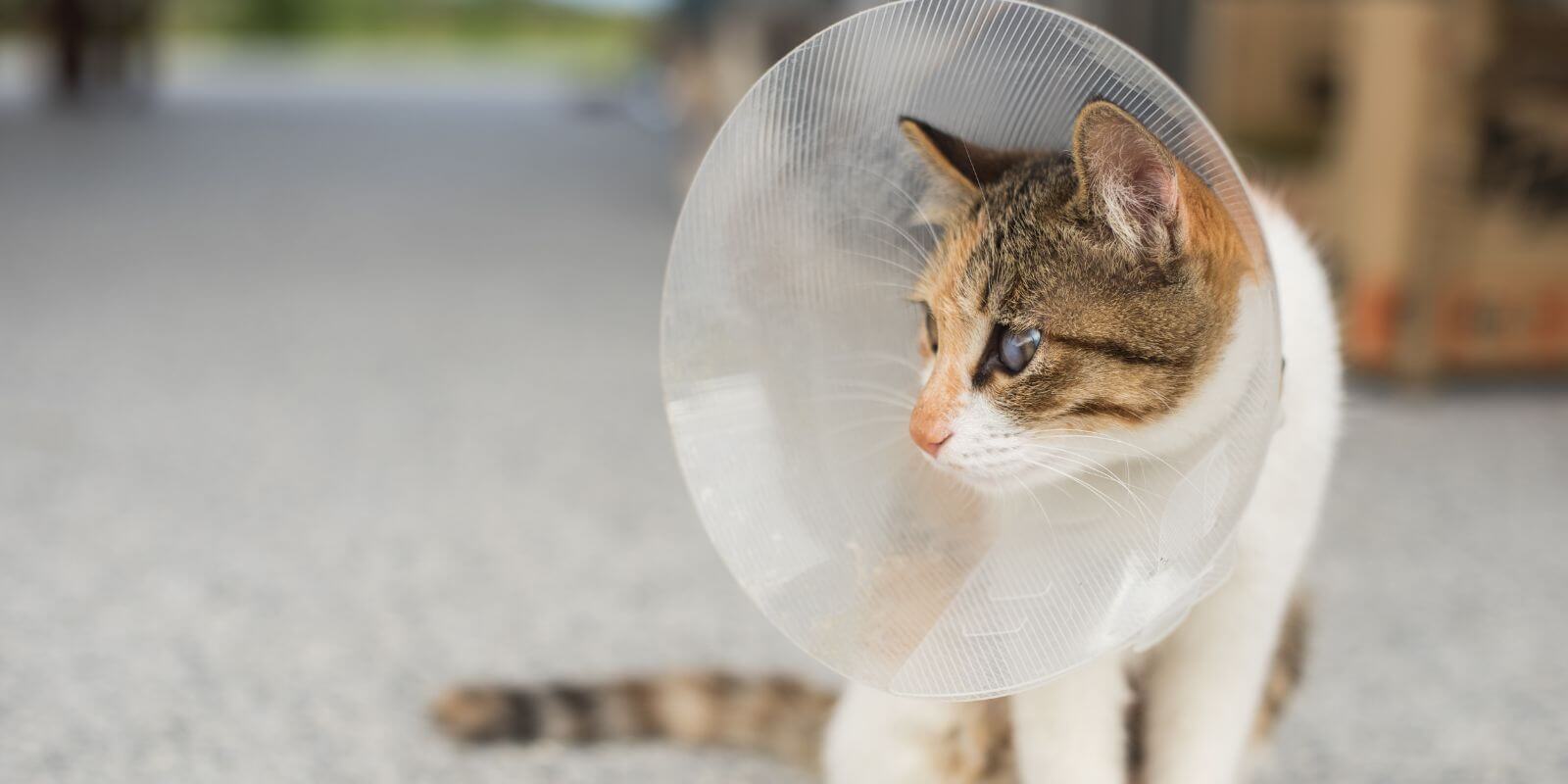As a new pet owner, or lifelong lover of animals, you may know or may have heard that it’s recommended to spay or neuter your pet. But what is spaying and neutering and why is it important? We’ll have a look at these important questions in your complete guide on spaying and neutering your pet.
Quick Links
- What is Spaying and Neutering?
- Why Would a Pet Owner Want to Spay or Neuter Their Pet?
- How Difficult Are The Procedures and What Are A Pet Owner’s Responsibilities?
- How Much Does it Cost to Spay or Neuter My Dog?
- What Age Should I Spay/Neuter My Pet?
- Are There Any Long-Term Downsides To Spaying or Neutering?
- Does Pet Insurance Cover Spaying and Neutering?
What is Spaying and Neutering?
Spaying and neutering are surgical procedures during which female (spay) and male (neuter) pets have their reproductive organs removed (gonadectomy). In females, the uterus and ovaries are removed and in males, the testicles are removed. We are generally referring to cats and dogs, but gonadectomy can also be conducted on other pets such as rabbits and ferrets.
Why Would a Pet Owner Want to Spay or Neuter Their Pet?
There are numerous reasons why owners should consider these procedures for their pet. From a social responsibility perspective, the main driver is to prevent unwanted pregnancies and to reduce and control the pet population. Literally thousands of unwanted dogs and cats are euthanized every year because they cannot be adopted out to a loving family who will care for them responsibly. In an effort to help control these populations, many municipalities have a trap, sterilize and release program - especially for cats.
From a medical perspective, a cat or dog that has been spayed or neutered will generally live longer and healthier lives. They will no longer be at risk of developing certain diseases and they will be less inclined to roam or stray away from home subjecting them to a variety of accidents, such as being hit by a car.
When females (especially smaller breed dogs) are spayed before the age of three years, they are far less likely to develop mammary (breast) cancer later in life. Once they are spayed, they can no longer develop uterine cancer, or uterine infections (pyometra) which are usually life threatening. Dogs and cats that experience multiple heat cycles (usually twice a year) are far more likely to develop uterine problems. If they experience a pregnancy, the likelihood of uterine issues increases even further.
When males are neutered the high risk of prostate problems are eliminated and they are no longer subject to developing testicular cancer. The risk of developing other forms of cancer that are related to excess male hormones are also reduced.
Some owners are hesitant to have their pet sterilized because they worry the pet’s personality will change in a negative way. Numerous studies have shown that this is not the case. In fact, behavioural problems that have a hormonal component, e.g. aggression, wandering, and territorial spraying are quite likely to disappear. Pets that are spayed or neutered tend to be less aggressive and more easygoing. Even though the main reproductive organs have been removed, there is still enough sex hormones (e.g. estrogen and testosterone) produced in the body to ensure your pet doesn’t morph into a different pet – either physically or in personality.
How Difficult Are The Procedures and What Are A Pet Owner’s Responsibilities?
It is important to discuss this with your veterinarian in advance, as there may be some variation from hospital to hospital. With either spaying or neutering, the procedure requires a general anaesthetic. Aneasthesia is considered very safe and routine. However, it is not without some risk and so it important to not feed your pet at least 8-12 hours before admission to the hospital. Your veterinarian may well want to do some basic blood tests in advance to help ensure everything goes as planned, along with using intravenous fluids and monitoring equipment during the surgery (just like human hospitals).
There are numerous different surgical techniques possible and some could involve a laparoscope to speed up post-surgical recovery. A male who has one or two retained testicles will have a different procedure than a male whose testicles are descended. You should discuss the procedure your veterinarian intends for your pet in advance.
Your pet may be discharged later that day or may be kept overnight. When sent home, most likely with pain control medication, it is VERY important that you keep your pet quiet (especially after a spay) and not let them lick the incision. There are a number of ways to help prevent this, which you can discuss with your veterinarian – e.g. soft Elizabethan collars and Thundershirts. The sutures (if they don’t dissolve on their own) need to be removed in about 10 days, after which your pet can resume its normal activities.
How Much Does it Cost to Spay or Neuter My Dog?
There are a lot of variables to consider when trying to determine the cost of spaying or neutering your dog. The first is whether you will take your dog to a shelter, rescue organization, or private veterinarian for the procedure. Each of these options has different costs associated with it. As a range, spaying and neutering can cost anywhere from free at a public adoption facility (the cost of the surgery is built into the adoption fee) up to $900 in a veterinary hospital.
Shelters typically charge less for the procedure, although there may be additional fees for things like vaccinations or microchipping and adoption fees. Rescue organizations often work with low-cost clinics or have their own fundraising efforts to keep the cost of spaying and neutering down.
The second variable to consider is the size of your dog. Smaller dogs typically cost less to spay or neuter than larger dogs. This is because the surgery is generally less complicated and requires less anesthetic.
The third variable to consider is the age of your dog. Spaying a young, appropriately sized (i.e. not overweight) female dog would be considered a more routine procedure, as compared to a middle aged, heavy Labrador that has had multiple litters.
The other variable to consider is where one lives. A rural veterinary practice may charge a lower fee, because their overhead is less than in a large urban centre. Additionally, the cost of providing veterinary medicine varies highly across Canada. On average, the costs in PEI are about a third of what they are in either downtown Toronto or Calgary.
What Age Should I Spay/Neuter My Pet?
There is no one-size-fits-all answer to the question and consequently there is subjective opinion and controversy involved. Ideally, it is important to discuss this with your veterinarian.
Historically, most cats and dogs were sterilized between 6-8 months of age. In the case of females, the major benefit of spaying before their first heat was to prevent female dogs from ever developing mammary cancer in their lifetime, as well as an owner dealing with a female dog in heat for 3 weeks with every self-respecting male dog coming around to play – especially on walks. Female cats in heat are vocal enough that many owners think they have been possessed by demons. In male dogs, the timing was primarily to avoid behavioural issues that might be on the cusp of developing.
Although not usually done so early, older studies indicated that puppies and kittens can be spayed or neutered as early as 8 weeks old with no significant health or physical issues later in life, but there is no rationale to do either procedure at such a young age in a family pet. The anesthetic risks are greater, so most veterinarians avoid this.
In the past 10 years, however, some studies have shown in SPECIFIC large breed dogs, that if one were to spay or neuter prior to sexual maturity, there is an increased risk of these dogs, particularly Golden Retrievers, German Shepherds and Rottweilers developing certain medical problems. For example, if performed less than 6 months of age, gonadectomy in Golden Retrievers and German Shepherds resulted in an increase in joint disorders when compared to intact dogs. 1,2 In Rottweilers that underwent gonadectomy less than 1 year of age, they were found to be at greater risk of developing certain bone cancers.
Because similar studies have not been yet done with other large breeds, it is difficult to extrapolate any possible risks to the plethora of large breeds that are family pets. The other consideration is that because pets that have either been spayed or neutered live longer, the risk of cancer developing will increase anyway. Because of all the benefits resulting from either spaying or neutering, many owners will want to stick with the traditional time frame of 6-8 months of age. With large breeds, though, it is worth having the conversation with your veterinarian as to any benefits to be gained by waiting until after sexual maturity; 12-18 months of age. With cats, with the exception of the potential for weight gain, there appears to be no reason to avoid pre-pubertal spaying or neutering.
Are There Any Long-Term Downsides To Spaying or Neutering?
As outlined above there are a great many benefits to spaying or neutering your pet. Once the procedure has been performed, the average pet’s metabolic rate does slow down as they mature. For this reason, it is important to watch out for any weight gain by carefully controlling all the treats and snacks with which we love to spoil them. Obesity in pets is very common and there is a strong, direct correlation between obesity and numerous other life-threatening medical issues. In female dogs, there is also an increased incidence of incontinence later in life (5-20%), but this can easily be controlled with oral medication.
So, if you're considering getting a new pet, be sure to consider spaying or neutering. It is always worthwhile to consult with your veterinarian to clarify the timing and the best procedure for your new furry friend.
Does Pet Insurance Cover Spaying and Neutering?
Pet insurance policies don’t typically cover the cost of preventive care such as spaying or neutering. Some insurance companies offer wellness add-on policies designed to cover routine and preventive care such as spaying or neutering, among other things. These wellness policies may have a limit on how much they will reimburse for the procedure, while others may only cover a portion of the cost. It's important to understand your policy and what it covers before you make any decisions about your pet's care.
Sources:
Hart BL, Hart LA, Thigpen AP, Willits NH. Long-term health effects of neutering dogs: comparison of Labrador retrievers with golden retrievers. PLoS One. 2014;9(7):e102241.
Hart BL, Hart LA, Thigpen AP, Willits NH. Neutering of German shepherd dogs: associated joint disorders, cancers and urinary incontinence. Vet Med Sci. 2016;2(3):191-199.
Cooley DM, Beranek BC, Schlittle DL, Glickman NW, Glickman LT, Waters DJ. Endogenous gonadal hormone exposure and bone sarcoma risk. Cancer Epidemiol Biomark Prev. 2002;11(11):1434-1440.



